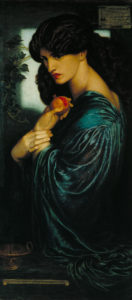Proserpine: A Multi-Layered Painting
[AdSense-A]
I have always been fascinated by Pre-Raphaelite art. The story of the secret brotherhood of English painters, poets and art critics who sought to turn art from the ‘grand tradition’ towards more natural settings, a greater focus on realism and building stronger connections between literature and art, was compelling to me.
I loved the bright colours and the achingly beautiful women they portrayed, but as a boy I never really appreciated the tragedy in them.
For reasons that I couldn’t comprehend my favourite artist was always Dante Gabriel Rossetti. I loved the stylised approach to his figurative work, the way that his models always had similar features. The heavily lidded eyes, the abundant and luxurious hair, and the long swan-like necks, I found genuinely breath-taking. Still do.
He was a complex character old Dante. Charming but lacking in confidence, constantly pulled between painting and poetry, he was hugely gifted but deeply flawed. A selfish man capable of great depths of love and sacrifice, he was destined to be carried on tidal waves of joy and dashed on sharp rocks of agony and turmoil. I relate to that only too well.
But it’s his Prosperine that I find myself returning to over and again. The painting represents the Roman Goddess who was condemned to live six months of every year in the underworld with its overlord Pluto. The usual features are all there, the delicate facial features, the long slender limbs, and the voluminous jet-black hair, all set off by the blue silk gown and the tendrils of exquisitely rendered ivy. Magnificent.
As a young man aching to become an artist it was the surface that appealed to me then. It is, after all, just a wonderful piece of work. Sumptuous, that’s the word I would use. Sumptuous. But I see it now, I see the terrible tragedy in it, the pain and suffering that it represents, both as an artwork and in the process of its production.
This what he had to say about it: ‘She is represented in a gloomy corridor of her palace, with the fatal fruit in her hand. As she passes, a gleam strikes on the wall behind her from some inlet suddenly opened, and admitting for a moment the sight of the upper world; and she glances furtively towards it, immersed in thought. The incense-burner stands beside her as the attribute of a goddess. The ivy branch in the background may be taken as a symbol of clinging memory.’
The painting is dated 1874 but it was the product of seven years and eight separate canvases before it was finally completed. And when you know the story behind it, the delays, starts and restarts make sense.
Prosperpine was hugely symbolic for Rossetti. After the disastrous relationship with Lizzie Siddal, who’d committed suicide shortly after ill-fated marriage, he’d returned to the arms of Jane Morris, the wife of the brilliant poet and renaissance man, William Morris.
Jane was the perfect Prosperpine. During the time this magnificent artwork was being created Rossetti was living with Jane at Kelmscott Manor during the summer months, while she returned to her husband in London every winter. From his perspective he provided for Jane’s escape from her unhappy union with Morris.
Yet Rossetti was ever the simplifier in making sense of affairs of the heart, if not in his work in art and poetry. He’d had the chance to marry Jane himself, but was too entangled with Lizzie at that time, so he’d actively encouraged Morris to pursue her. As a poor young woman with limited prospects it was virtually a fait accompli.
They had some moments in the sun Jane and Rossetti, but it was never going to end happily. The pain they experienced and caused soured their lives and those around them. William was incredibly stoic and tried to avoid any scandal, but it wasn’t to be. At the end the lovers were completely estranged, and none of the Morris family even attended Dante’s funeral.
Despite these stories, each of them worthy of the Arthurian romances they adored, the body of work remains. While I can still see the aesthetic wonder in the painting of Prosperpine, its meaning has changed my perception of it forever.
That, of course, is the legacy of great art
Radical Rhymes is a professional artist working with a range of media – predominantly animal/human portraits and landscapes – including, most recently, hand painted furniture. You can see his work on Instagram Radicalrhymes1969 or on Twitter @RhymesRadical.
For commissions, please contact him on Twitter via Direct Message or by email at: radicalrhymes@outlook.com His work is also available to buy on Etsy
[si-contact-form form=’2′]


